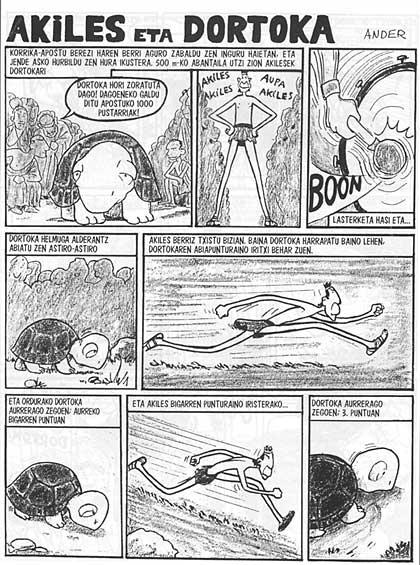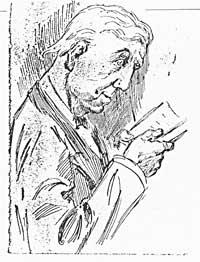Paradoxes (and II)
1991/11/01 Angulo, Patxi Iturria: Elhuyar aldizkaria
Is there room for more?
Imagine that the reader has all his rooms occupied in a normal hotel. One morning a traveler arrives asking for a room. The reception refuses saying that there is no room. Typical situation.
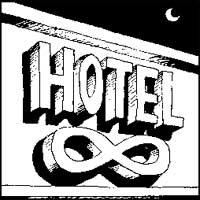
Think now of an amazing hotel. This hotel has infinite rooms and all full. A passenger has arrived and the host, with pleasure, says: we have all the rooms full, but we will look for a room for you. What will the receptionist do to give a room to the traveler if everyone is full?
Moreover, imagine that an infinite group arrives the same day to participate in an event. Now the number of tenants to be installed is infinite. However, the reception, thanks to the experience, has been well adapted and has placed all tenants in each room. How did he get it?.
These paradoxes are firmly consolidated in the theory of Georg Cantor's transfinite numbers, first presented in the 1920s by the German mathematician David Hilbert. The mathematician Georg Cantor, also German, was the first to find the right method to overcome the paradoxes that the infinite groups generated since ancient times. These paradoxes of infinity also existed in ancient Greece of the Zenons of Elijah.
In 1634, Galileo, in his book Conversations about the New Sciences, in researching a problem similar to the infinite hotel, understood that the square numbers of natural numbers and natural numbers were infinite; by bijection n´n 2, he established that both sets had the same number of elements. However, he did not realize by basing himself on the postulates of Euclid (everything is the sum of its parts). For his part, Cantor included in the definition of the infinite set an individual correspondence: an infinite set is one that can be placed in an individual correspondence with a part or subset of his.
Thus emerged the transfinite numbers representing the cardinal (number of elements) of the infinite sets. The first transfinite number is N0 (alef-zero) and represents the number of natural numbers.
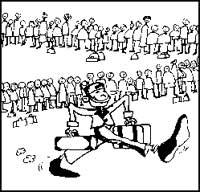
The resolution of our paradoxes is based on the definition of infinite sets. In the first, the host person will pass to the tenant from room 1 to room 2, from 2 rooms to 3, from 3 rooms to 4 rooms and so on to all the tenants who have come to room 1. The rooms and tenants in the infinite hotel are N0, after giving room to the new tenant the number of tenants will be N 0 + 1, while the room has not varied N0 and yet N 0 + 1 = N0.
In the second, the reception will take the tenant from 1 room to 2 rooms; 2 rooms to 4 rooms; 3 rooms to 6 rooms; 4 rooms to 8 rooms, etc. (n´2n). Thus, rooms 1, 3, 5, 7, 9... will be free and will introduce in them new infinite tenants (n´2n - 1). This time the new number of tenants is N0 + N0 and the number of tenants is N0. Therefore N0 + N0 = N0.
As you can see, Euklides' postulates cannot be applied to infinite sets. Nor are the laws of common arithmetic fulfilled.
Does the barber have a beard?
A single barber lives in a small village. His job is to shave all those who do not shave. The barber is down because he doesn't know if he has to remove his beard.
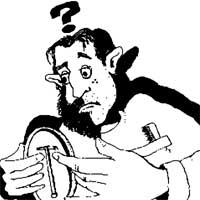
And it is logical to remove his beard himself, but if he clings to himself does not meet the condition to be able to shave. And if the beard is not removed, depending on the condition, the beard should be removed. It is not a barber problem. What should he do?.
Paradox published by the English philosopher Bertrand Russell in 1918. In humble words, in the village there are two types of people: those who shave and do not take off. The real question is what group is the barber?. The truth is that the barber cannot exist because his existence would lead to contradictory consequences.
However, the issue is not so simple, as the structure is similar to the other paradox of Russell, the sets that are elements of himself. The essence of this paradox lies in recognizing that each property or description has a set. For example, you can define the set of satellites that the Earth had 100 years ago, being its only element the moon. However, the set of artificial satellites lacks elements. However, there is (empty set). Russell's paradox refers to sets that are or are not elements of himself. For example, the rainbow color set is not an element of the set (of your head), but a set. However, the set of sets with more than 10 elements has more than 10 elements.
It is therefore an element of itself. If we call set H, the set of birds, h, is its element; the set of rivers, i also; that of cars, k; that of fish, a; that of letters, l; that of people, p; that of dogs, z; that of cows, b; that of hours, or; that of mountains, m; that of phones, t; …, that is:
H = {h,i,k,l,p,z,b,m,t,...}
Therefore, the same H has more than 10 elements
H = {h,i,k,l,p,z,b,m,t,H,...}.
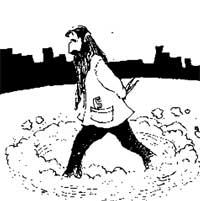
Let's go back to groups that are not considered elements. The question is: is the set of all sets that are not elements of themselves? As with the barber, and in humble words, the set of all sets that are not elements of itself is not an element of itself, only if it is an element of itself. Of course, there is contradiction here.
To resolve the case, Russell rejected the idea that a set corresponded to each predicate. He said that the predicates that produced contradictory effects had no meaning, since they did not create sets. That is, defining a set does not mean that the set exists. Thus, the square circle cannot be defined, because they are contradictory concepts. Russell's resolution forces us to leave concepts about the whole and the truth rooted in intuition.
There is another method to eliminate the contradiction of the paradox. One needs a set theory based on a multipurpose logic and not a valid logic. In this system denial loses its meaning. Therefore, you can admit a set that is an element of itself and at the same time is not.
Are all candles black?
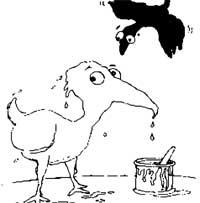
Before the candle cage, an ornithologist says:
- Here are two of the most beautiful beauties I have ever seen. Discover its black feathers. They owe their name. After explaining the customs of these birds, a young man asks:
- Sorry teacher, but do you say that all crows are black?
- I do not know if I have said these words, but yes. All candles are black.
- How can you be so sure?
- Well, in my life I've seen hundreds of crows and they were all black.
- Okay, but there are hundreds that are not all. How many candles do you think there are?
- Several million. Going back to your question, many people, scientists and non-scientists, have analyzed the candles for thousands of years and none of them, as far as I know, does not mention any candle that is not black.
- Therefore, one cannot speak of everyone, but of almost all ravens.
- But there is more evidence. Think, for example, of these beautiful multicolored birds, parrots, toucans, turkeys, ...
- Yes, they are beautiful, but I don't know if they have to do with the claim that all crows are black.
- Don't you really understand?
- No. Would you explain it to me?
- Well. Do you accept that every black grain confirms generalization?
- Of course.
- Well. So, the statement “all candles are black,” logically, amounts to the statement “all non-black things are non-black.” This being so, and considering that any case that confirms a statement confirms its equivalents, all non-black claims that all crows are black. Therefore, these beautiful multicolored birds, not even black ones, confirm it.
- That is absurd," the young man replied. With this criterion, your blue jackets and grey pants also confirm that all candles are black. Because they are neither candles nor black.
- Yes," says the ornithologist. I know you are learning to reason as scientists.
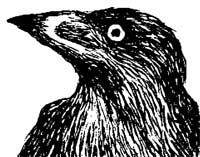
Bethlehem's paradox sparked great controversy among scientific philosophers in the mid-1940s, when the German Carl Hempel explained in Studies in the Logic of Confirmation. The paradox of crows, of affirmation, is of inductive logic. Therefore, it is not a logical conclusion derived from the real premises. This problem is paradoxical, since two principles of inductive logic (affirmation and equivalence) are derived to logical effects opposite to intuition.
It seems that the inductive logic is based on the principle that generalizations like “all veils are black” are confirmed by cases, that is, every black recovers generalization. Inductive logic does not admit certainty. Generalization can only be said that so many tests are validated. On the contrary, a single non-black veil is sufficient to reject generalization.
Debate not only the principle of affirmation but also that of equivalence. They are two equivalent statements, only if one is true and the other is false. Therefore, when they have the same title. Therefore, if two equivalent statements have the same execution value, one case that confirms one affirms the other. Likewise, if a case rejects one, both will be rejected simultaneously.
Hempel claims that the paradox is due to a misinterpretation of the extent of universal generalizations. He recognizes that the generalization “all crows are black” is affirmed by white pigeons, rainbow, etc. In common language, diffusion is limited to grammatical subjects of generalizations (crow, black). Logically, on the contrary, its diffusion is unlimited, that is, it encompasses everything (even what is not black).
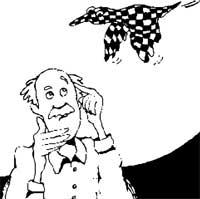
Hempel considers that “all crows are black” as a statement of generalization, the obstacle to admitting non-blacks is to interpret generalizations according to previous knowledge. Therefore, intuition tells us that the existence of white doves, rainbow, etc. has nothing to do with the generalization of the colors of crows, but logic shows that intuition is wrong.
Some philosophers have tried to show that non-Black cases confirm generalization at different levels. The starting point of these ideas is that the number of candles is less than that of non-black and non-black. According to this theory there are three methods to achieve the ultimate affirmation: to analyze all crows (until it is proven that all are black); to analyze all non-black things and determine that none is candle; or finally, to analyze all things and determine that there are no non-black crows. It seems that the most sensible thing is the study of veils. It seems lawful to say that the weight of seeing a black veil is greater, since proportionally between crows a black crow has more weight than among non-blacks a white dove.

Gai honi buruzko eduki gehiago
Elhuyarrek garatutako teknologia




